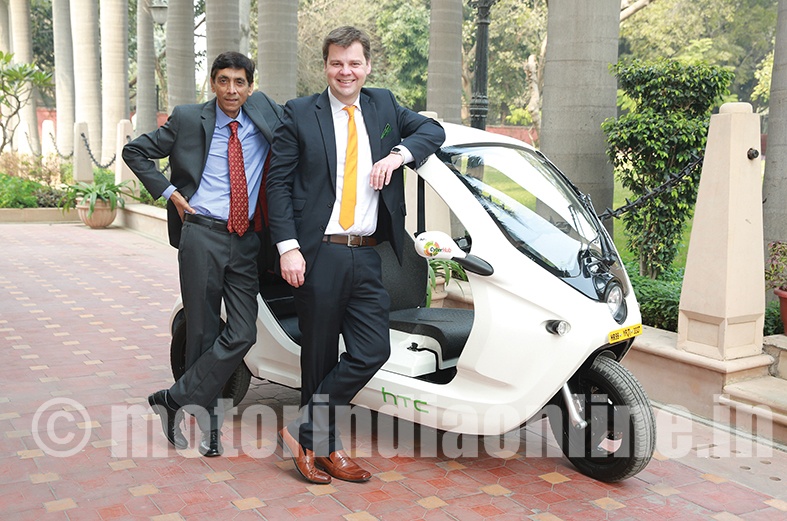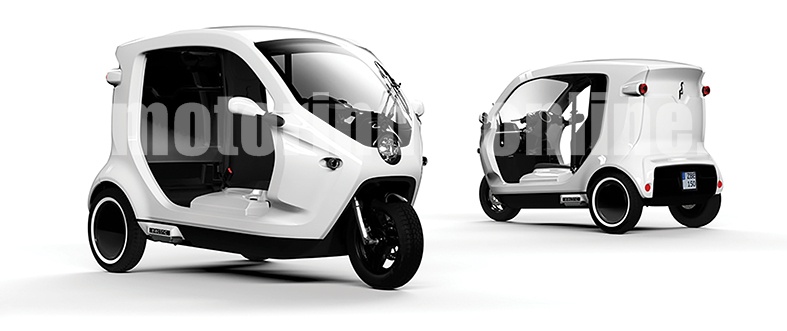Clean Motion, a leading Swedish electric vehicle technology provider, recently rolled out the Zbee (pronounced as ‘Zee Bee’), a zero emission vehicle as a sustainable solution to the country’s last-mile connectivity concerns. Positioned as a safe, simple and efficient public transport system, Zbee has already kicked off its first ride at DLF Cyber Hub, Gurgaon, with a cluster of 10 vehicles already running between DLF Cyber Hub and nearby offices. Another 15 will be added to the existing fleet.
Priced at Rs. 5 lakhs, the three-wheeled electric vehicle will see a 50 per cent price reduction once the company locally manufactures the product. Having a seating capacity 2+1, the vehicle will also be available in other cities like Noida, Bangalore, Jaipur, Hyderabad, Agra, Chandigarh, Mumbai, etc., in the first phase. At present, the passenger fare has been capped at Rs. 30 for a single journey.

In an exclusive interaction with MOTORINDIA, Mr. Anil Arora, Country Head, Clean Motion India, stated: “‘Public Transportation’, ‘Last Mile Connectivity’ and ‘Sustainability’ are going to be the key components of the proposed Smart Cities in India. We will be a critical element of smart city development by addressing the last-mile connectivity issues which are plaguing Delhi and other metro cities. Between the low-end auto rickshaw and a high-end cab, there is a huge void which we are filling by providing a vehicle which is clean and safe. As the country moves toward investing in creating a world class infrastructure across its cities, we will also widen our presence by providing our cutting-edge solutions for such cities.”
Clean Motion India has stated that it will be carving its niche without eliminating any other forms of transportation. “Here we will be doing our bit is by providing efficient last-mile connectivity to passengers from BRT, Delhi Metro station or any public transport to their final destinations. Our end customers, the aspiring middle class, would be looking for premium yet fairly-priced commuting solutions. The public transport does not give a door-to-door pick and drop for commuters. You have to get off and walk three or four kilometres ahead to retail, commercial or residential formats. For example, if you get down at a metro station and want to go a few km to the mall, we will fill in that need for you. Currently, we are serving the corporate executives who want to come for a meal at Cyber Hub and go back to their offices.”
It may be recalled that Clean Motion was formed 7-8 years back and the first Zbee was developed at Gothenburg, Sweden. This is the second generation model available in India. Engineers from Volvo, VW and AutoLiv have been deeply involved in this project. The company operates out of Europe, Spain, France, Switzerland, Norway, Indonesia, etc.
However, India is poised to be one of its biggest markets for this product at 5 lakh units per annum since its product runs on three wheels. As Mr. Arora affirmed, “There are over 200 players in the e-rickshaw market. But out of that, there are only a handful of them who are organised players selling standardized products. From the design and safety perspectives, ours is the first L5 category vehicle in India which is certified with iCAT and ARAI. Unlike e-rickshaws which undergo three tests, there are atleast 15-20 tests that we have to do in order to comply with the safety and other regulations. More than a three-wheeler, ours is a connected vehicle, and we also use advanced Lithium-ion batteries, and apart from (Mahindra) Reva, we are the only company which has got batteries which are certified under the Automotive Indian Standards.”
Apart from Gurgaon, Zbees will also be seen on the Delhi roads at the DLF Place Saket mall, and will connect the Malviya Nagar station to the mall by July. The first cluster of Zbees will have 20 vehicles, with Lithium batteries that allow for charging in 20 minutes. A full charge would take less than an hour and will allow for driving for up to 50 km.
Meanwhile, Mr. Arora maintained that its business model will be very different from that of its peers. He was categorical in stating that Clean Motion India will not be using the automotive distribution model of a dealer selling to the retail customer. “We don’t adopt the standard automotive distribution model. We will be doing the cluster approach, or what you call as the hub-and-spoke model. We operate through a franchisee business model on the lines of McDonalds (in India). Each franchisee gets 25 vehicles after paying the franchisee fee, and it is a joint operation where we work on a profit-sharing basis with our channel partners. The entire service and maintenance of the vehicle will be taken care of by us. We will be regularly involved in the day-to-day operations of the business. Our end customers will get the same service whether you take the vehicle at 8 a.m. or 8 p.m.”, stated Mr. Arora. “We are there with our own vehicles. We are also building our own app to enable vehicle on demand for three-wheelers. We are looking to outsource it to someone who has the app for three-wheelers.”
Shedding some further light on the product, Mr. Arora shared: “The vehicle is coming from Europe and we have sold 25 units since then. We should be able to do 500 units this year. We will be highly localizing the product as we have built a manufacturing facility at Faridabad. There are 230 components for building this vehicle. We will locally making the sheet metal and stamp components in the first phase of production. The windscreen glass is coming from Hindustan Glass (Safex) and tyres from Hankook India. We are in the process of localising other components. With are aiming to go for 70% indigenisation which will enable us to bring down the price by 50%. Having said that, the entire drivetrain comprising the batteries, motors and controllers will continue to be imported from Sweden.”
Apart from cutting down greenhouse gas emissions, Clean Motion India is also looking at creating additional skilled jobs which will be a source of livelihood for many people who will be trained by the company. “Besides drivers, we need ticket collectors, supervisors, technicians, operators and support staff. I have got 20 people working at Cyber Hub. We are talking to DIMTS and are also planning to have women drivers on our rolls,” stated Mr. Arora.
Clean Motion has so far invested over $1 million in the country and would be pumping in $10 million by 2017. The amount invested is partly for capex on vehicles, partly on Opex and partly for manufacturing expenses.
Talking about its future course of action, Mr. Arora highlighted: “We are looking at inter-connected clusters in two to three years. Once the proper infrastructure (like metro stations in phased III in Delhi) is established, then we can interconnect between various clusters. Eventually, you have to connect the whole city with these clusters, and then you have intra-city operations with these clusters, and then you can have an intra-city operation when you 50 clusters and 200 charging stations. We are also looking to go beyond Delhi as there are 100 franchisee enquiries from all over the country, including Nepal. We will also be floating infrastructure development business. We are setting up charging stations with solar panels.”
By FY 2017, Clean Motion India is anticipating a sale of 2,500-3,000 units per year. By that time, the price of the vehicle would be around Rs. 2.5 lakhs due to heavy indigenization. In the next four to five years, the company is planning to sell 100,000 units which would be around 20 per cent of the existing three-wheeler market in five years. Also on the anvil is a product with a solar panel on the roof (30 per cent additional range), which is currently being tested in Europe.
“We are bringing in the cargo version which will be catering to e-commerce firms on a franchisee basis. We are also thinking of a four-wheeled version of our vehicle,” concluded Mr. Arora.
